
While many readers here are well past the point of their first raw denim purchase, we figure there are just as many who are fresh to the entire concept. If by chance you fall into this bucket, there are a few things you should take into account when you decide to take the plunge. Note as well that pinpointing the “perfect pair” is never an easy feat. There are so many attractive options on the market, not to mention brands offers a multitude of fits and fabrics.
Right off the bat, however, the easiest and best solution is to head to a store that offers a healthy range of raw denim and is run by a knowledgable staff. This should give you an excellent opportunity to try a lot of different pairs as well soak in advice given by someone who knows their trade.
The fact remains though that raw denim is still not always easy to obtain, and the internet is the only option many people are left with. Finding the goods on the web is not a problem at all, but many people struggle with the unknown and end up in a dilemma with a lot of unanswered questions. To help you through some of the basic challenges you may encounter, we walk through the denim buying process in five simple steps.
1. Know Your Measurements
First and foremost, you need to know your measurements. One of the easiest way to do this is to take one of your own pairs of denim or pants that have what you consider to be an ideal fit. From the images below you can see what measurements are required when buying a pair of raws, then by means of a simple tape measure, you can reproduce the same measurements on your own pair.
While you’ll still want to double check the measurements with the retailer (particularly if you’re purchasing online), below is the common seven-point criterion to get you moving in the right direction.
Waist (Band)
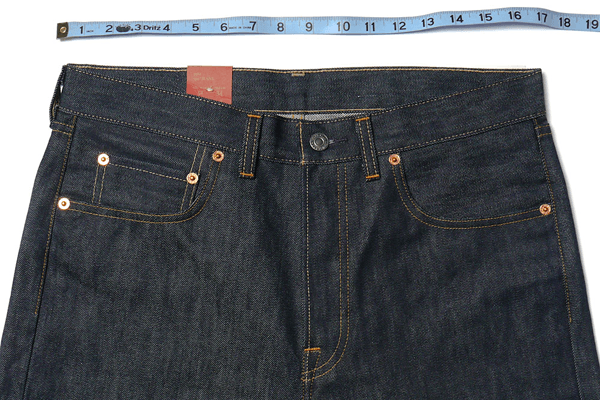
Based upon this pair of LVC 501, the denim measures approximately 16”, or 32″ total (note: tape not laid flat in image)
Lay your denim on a flat surface and pull the front waistband up so that it is on the same level as the rear waistband. Measure your waistband from left to right and multiply by 2 to find your waist size.
Inseam
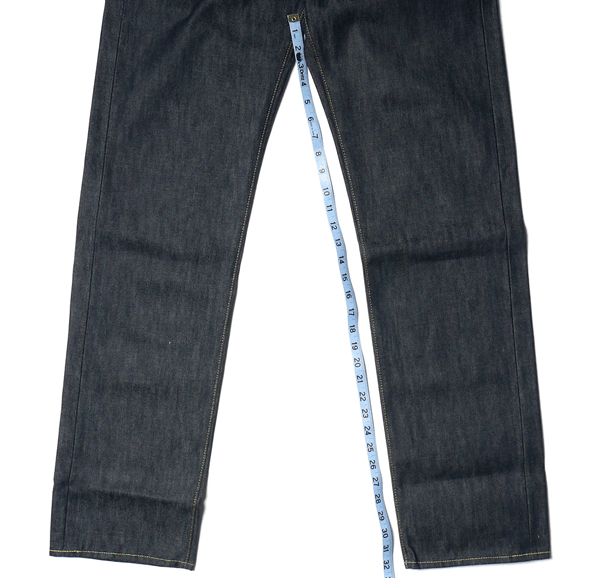
Inseam measurement in this case is 34’’ (note: tape above not measured exactly from crotch)
Start with your tape in the center of the crotch and measure alongside the inseam until you reach the hem.
Leg opening/hem
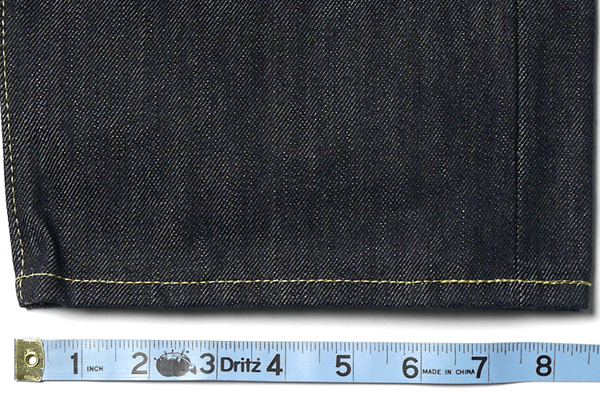
The leg opening measurement of this pair is 8.5’’
To measure the leg opening, place the front and the back of the hem in-line so that they are on the same level. Now measure the width of the hem.
Upper Thigh
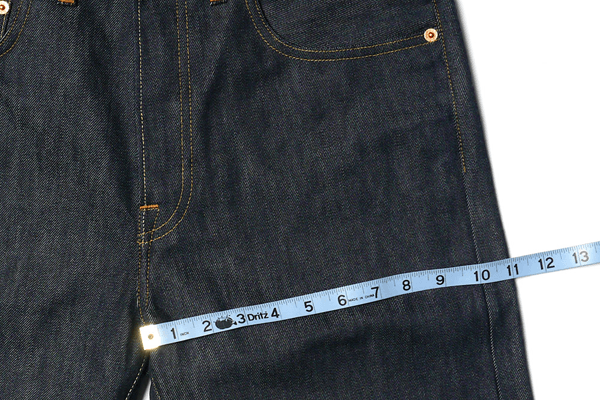
The upper thigh here measures 12’’
Measure horizontally from the crotch to the outside of the leg as shown in the image above.
Knee
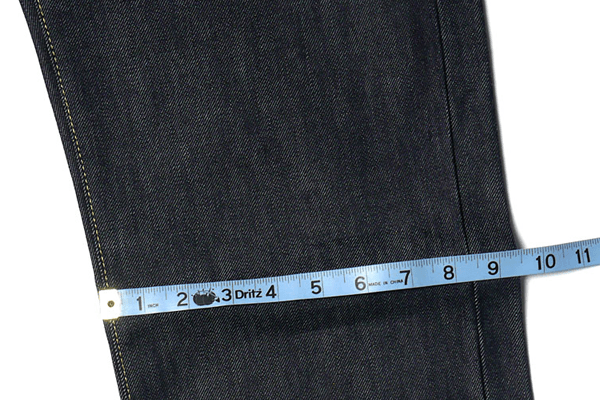
The knee of this pair measures 9.5″
Start with your measuring tape in the center of the crotch and measure 13” downwards, alongs the inseam.
From this point turn your tape horizontally and measure the width of the leg. This will give you your knee measurement.
Front rise
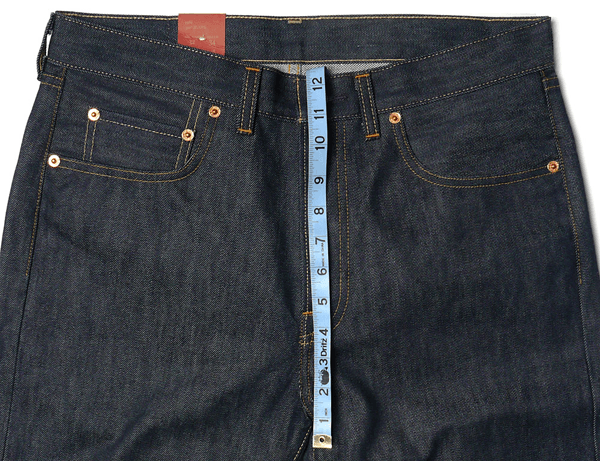
The measurement here is 12’’
Measure vertically from the crotch to the top of the waistband with your denim facing up.
Back Rise
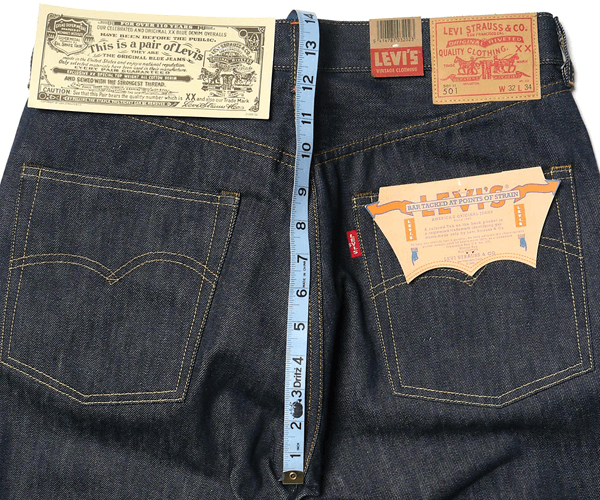
The back rise on this pair is 14″
Measure vertically from the crotch to the top of the waistband with your denim facing down.
2. Determine Your Budget
It goes without saying that a pair of raw denim is a quality item. It’s durable and can last you for years assuming it is maintained and treated well. The weight of the denim is an important aspect that determines the quality and durability of a pair. For this reason the higher weights denim (17 oz. and up) are traditionally more expensive. There is also a big difference between handcrafted jeans and those made in a mass production factory. Some brands make their denim by hand and in small batches, a time-consuming process but one which can give the denim a story and more character.
The price for a decent pair of raw denim starts around $80.00 and can go up as high as $2,000.00 in the exorbitant case of the Momotaro handwoven G001-T Gold. Think about what you are willing to pay for a pair of raw denim and try to stay in your price range. For a few examples, see our lists of raw denim under 100 dollars, between 100 and 200 dollars, and between 200 and 350 dollars.
3. Sanforized or Unsanforized
Before you move forward on any one specific denim, you’ll want to know whether the denim is sanforized or unsanforized as both options call for different sizing methods. We previously published an article on sanforization which makes for a useful reference in fully understanding the sanforization process. To re-cap though, the basics of (un)sanforization follow below.
Sanforized
Most raw denim is sanforized, meaning that they’ve been treated with water once to avoid any shrinking that may have occured during your first wash. When buying a sanforized pair, although they how will stretch roughly 0.5″ – 1.0″ with wear, bear in mind that they will shrink roughly 1% – 5% and you will need to size down accordingly.
Unsanforized
While more uncommon, numerous vintage brands still utilize unsanforized denim. Implied within the name, this is raw denim that has not undergone the sanforization process and thus will shrink a fair amount when they are washed or soaked for the first time. Most pairs will shrink about 7% – 10% which could be 1.5 to 3 inches in total, if not more. Due to this immense shrinkage, one often sizes up so that the denim won’t be too tight or short after the initial soak.
4. Picking The Right Size
At this point you’re likely starting to really hone in on a few makes and models. Before jumping ahead though, you’ll want to combine steps 1 and 3 above in order to determine the optimal size you need. This is sometimes as easy as referencing a sizing table on the site (note this is not always 100% reliable) or emailing the store owner.
In general though, it will boil down to three options:
True to Size (TTS)
Buying the size tag that has the closest measurements compared to yours.
Sizing Down
Buying one or more size tags smaller than what you currently measure. This is typically the case when buying a denim that stretches a lot and/or you know you’ll be wearing heavily. The caveat with tight-fitting denim is that they are more prone toblowouts, but if you’ve done your homework well enough (see step five), this will be an easy decision.
Sizing Up
Buying one size tag or more larger than the size that compares to your measurements. This could be the case with denim that is very sturdy/strong/tough and has little to no stretch, denim that is smaller and tighter in certain areas, and/or denim that is unsanforized or shrink-to-fit.
5. Pick a Brand And Do Your Homework
Without doubt, this step is completely personal and depends on your taste and style. What color denim do you like? Do you like visible backpocket stitching or would you like them to be clean and simple? Do you prefer slim, straight, skinny, etc.?
Nearly every brand has a few different styles and fits. Pick a few that suit you best and search attain as much information as you need to make the decision comfortable. There are a number of online options of course, including yours truly and a variety of forums.
In essence, although buying your first pair of raw denim can sometimes be a daunting process, it doesn’t necessarily need to be. We believe following this succinct five-step guide is a great approach to getting the job done right the first time, but if you have another process, let us know through the comments below.

No comments:
Post a Comment